Parlor Palm Vs Areca Palm – How To Distinguish Between The Two?
Parlor palms are smaller in appearance whereas Areca palms are slender and taller. The leaves of parlor palms are slightly wider as compared to areca palm leaves that are thinner & longer.
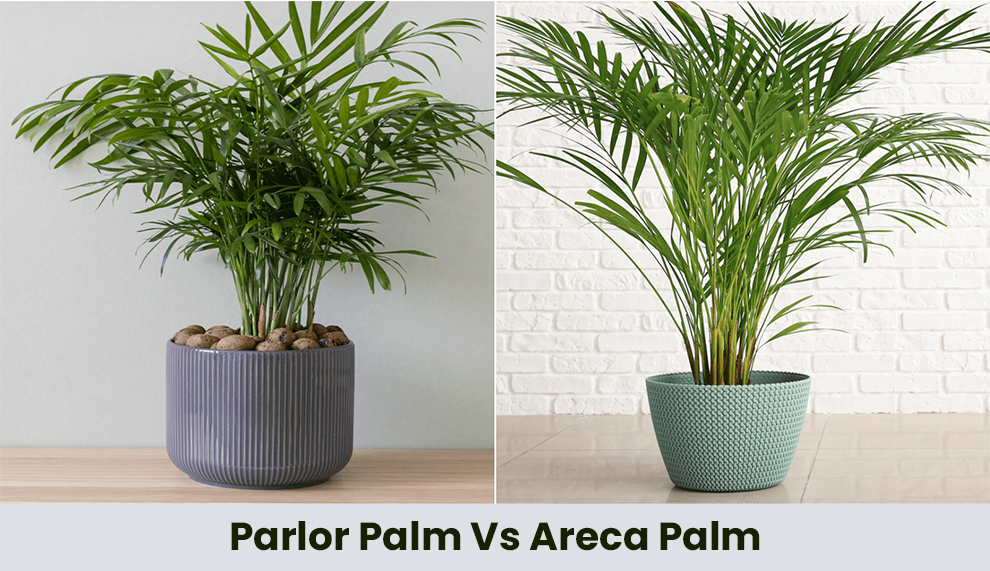
Areca palms and Parlor palms are two popular types of indoor palms that are often confused with one another due to their similar appearance. However, there are several distinguishing features that set these two types of palms apart.
One of the most distinguishing features of areca palms is their height and the second is their leaves.
On comparing the height of Parlor palms vs. Areca palms, you will know that areca palms can grow up to 20 feet tall in their natural habitat, although they typically reach 6-7 feet when grown indoors. On the other hand, parlor palms are much smaller in size and rarely exceed 4-5 feet in height.
Areca palms have long, feathery fronds that arch gracefully, giving them a distinctive tropical appearance. But parlor palms have bamboo-like stems and delicate, fan-shaped leaves that grow in a compact rosette.
While they may not be as tall as areca palms, parlor palms are highly adaptable and can thrive in a variety of indoor environments, even in low-light conditions.
In this article, we shall study the various distinguishing features of Parlor and Areca palm trees.
Areca palm vs. Parlor Palm – What’s There To Observe?
| Areca palm | Parlor palm | |
| Scientific Name | Dypsis lutescens | Chamaedorea Elegans |
| US Hardiness Zone | 9 to 11 | 10 to 12 |
| Height | 6 to 7 feet | 4 to 5 feet |
| Leaves shape & color | Feather-shaped, long, and pinnate leaves. Bright, vibrant green in color. May develop a slightly yellowish tinge as the plant matures. | Fan-shaped leaves that are rich, dark green in color. They are shorter and wider as compared to the Areca palm. |
| Fruit & flower | Small, oval-shaped fruits that are green at first and yellowish-orange when ripe. The flowers are yellow in color, small, sweet-smelling, and grow in clusters.
Nonedible fruit berry. |
The fruit of a Parlor palm is a small, round, blackish berry. Flowers are also small and inconspicuous with a yellow center and greenish-white petals.
Nonedible berries. |
| Soil | Areca palm grows best in well-draining soil that is rich in organic matter. | Parlor palm prefers a well-draining soil that is slightly acidic and rich in organic matter |
| Temperature | Areca palm prefers warm temperatures between 65°F to 75°F (18°C to 24°C) and can tolerate temperatures as low as 55°F (13°C). | Parlor palm, on the other hand, prefers cooler temperatures between 60°F to 70°F (16°C to 21°C) and can tolerate temperatures as low as 50°F (10°C) |
| Water needs | Areca palm, on the other hand, prefers to be kept slightly moist at all times. The soil should never be allowed to completely dry out, but the plant should not be overwatered either | Parlor palm prefers to be kept evenly moist but not waterlogged. The soil should be allowed to dry slightly between waterings, and the plant should be watered thoroughly when the top inch of soil feels dry to the touch |
| Fertilizers | Balanced, water-soluble fertilizer with NPK (Nitrogen, Phosphorous, and Potassium) in a ratio of 3-1-2 or 3-1-3. | Also prefers a balanced, water-soluble fertilizer with NPK in a ratio of 3-1-2 or 3-1-3. |
| Lifespan | 8-10 indoors
20 years or more outdoor |
Several decades. |
| Growth rate | Areca palm is a relatively fast-growing plant and can reach a mature height of 6-8 feet (1.8-2.4 meters) indoors within a few years, and up to 30 feet (9.1 meters) tall in the wild. | Parlor palm, on the other hand, is a slower-growing plant and typically takes several years to reach its mature height of 3-4 feet (0.9-1.2 meters) indoors |
| Pet friendly | No | Yes |
| Uses | This decorative plant is used in large indoor spaces or landscaping. Also has an air-purifying quality.
Used for weaving baskets, mats & more handicraft items. |
Also, a decorative plant that is primarily used in small indoor spaces like bedrooms. It has air-purifying features too. |
| Infestation to worry about | Spider mites, Mealybugs, and Fusarium wilt | Prone to spider mites, Scale insects, and Root rot |
| Cost | A small to medium-sized Areca palm plant can cost anywhere from $20 to $50, while a larger plant can cost up to $150 or more. | A small to medium-sized Parlor palm plant can cost anywhere from $10 to $30, while a larger plant can cost up to $100 or more. |
Areca Palm Vs. Parlor Palm – Noticeable Physical Differences & Growth Habits
Let us look at the origin of these two plants and the physical differences that are visible to the naked eye.
A. Classification & Plant Origin
Areca palm variety (Dypsis lutescens) belongs to the Arecaceae family and is native to Madagascar and South India. It is also commonly known as the golden cane palm, yellow palm, or butterfly palm.
Parlor palm (Chamaedorea elegans) belongs to the family Arecaceae as well and is native to Mexico and Guatemala. It is also known as Neanthe bella palm or bamboo palm.
B. Plant Size (Height & Spread)
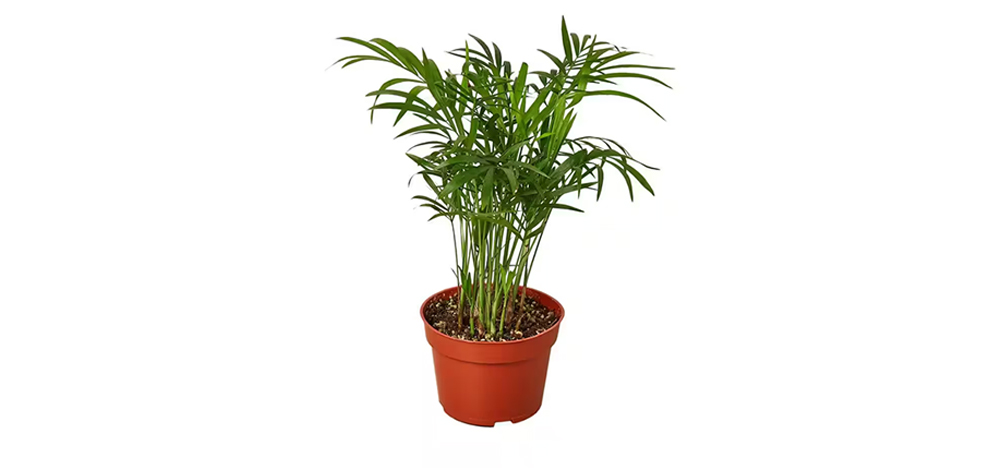
Areca palm typically grows to a height of 6-8 feet (1.8-2.4 meters) indoors, and up to 30 feet (9.1 meters) tall in the wild. The plant has a relatively narrow spread, usually reaching 4-6 feet (1.2-1.8 meters) wide when grown indoors.
On the other hand, Parlor palm has a slower growth rate and typically reaches a height of 3-4 feet (0.9-1.2 meters) indoors, and up to 6-8 feet (1.8-2.4 meters) tall in the wild.
The plant has a compact growth habit and tends to have a smaller spread than the Areca palm, usually reaching 2-3 feet (0.6-0.9 meters) wide when grown indoors.
C. Leaf Shape, Size, and Texture
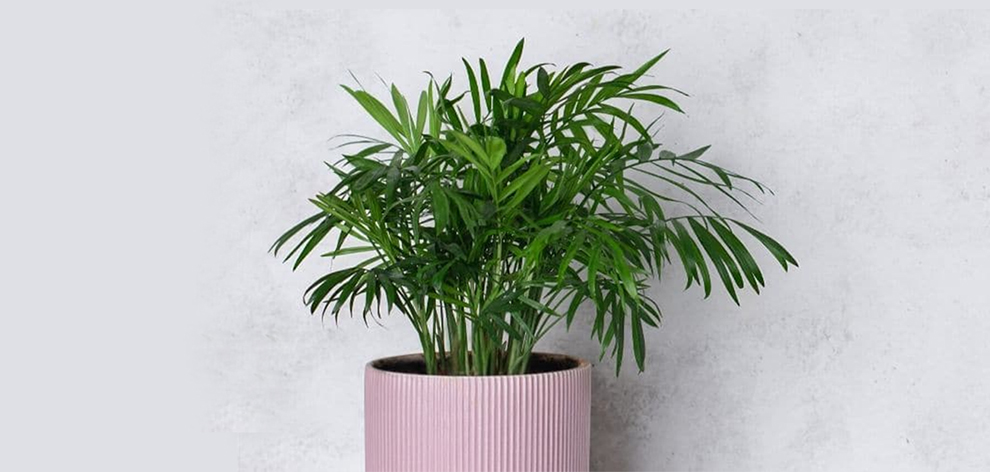
Areca palm leaves are pinnate and can grow up to 6-8 feet (1.8-2.4 meters) long, with a width of about 2-3 feet (0.6-0.9 meters). The leaves are bright green, with a glossy texture and a feathery appearance.
Each leaf has numerous narrow leaflets that grow from a central rib, creating a graceful arching effect.
Parlor palm leaves are also pinnate, but smaller than those of the Areca palm. They typically grow up to 2-3 feet (0.6-0.9 meters) long, with a width of about 1-2 feet (0.3-0.6 meters).
The leaves are dark green and have a softer, more delicate texture compared to the Areca palm. Each leaf has numerous narrow leaflets that grow from a central rib, creating a compact, bushy appearance.
D. Do They Both Have Similar Flowers?
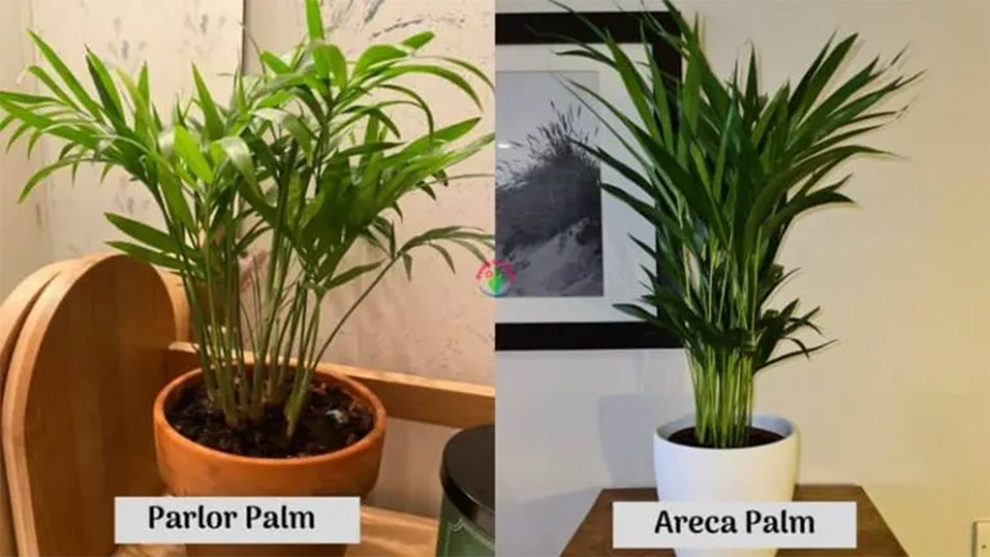
Areca palm and Parlor palm are both flowering plants, but the appearance of their flowers is different.
Areca palm produces small yellowish-white flowers that grow in clusters on long stalks that emerge from the base of the leaves. The flowers are typically hidden by the plant’s foliage and are not very showy.
Parlor palm also produces small flowers that are yellowish-green in color and grow in clusters at the base of the leaves. The flowers are not particularly showy either and are typically hidden by the plant’s foliage.
While both plants do produce flowers, they are generally grown for their attractive foliage rather than their blooms.
E. Growth Rate & Lifespan
When it comes to Chamaedorea Elegans vs. Areca palms, Areca palm is a relatively fast-growing plant and can reach a mature height of 6-8 feet (1.8-2.4 meters) indoors within a few years, and up to 30 feet (9.1 meters) tall in the wild. With proper care, an Areca palm can live for 20 years or more outdoors.
Parlor palm, on the other hand, is a slower-growing plant and typically takes several years to reach its mature height of 3-4 feet (0.9-1.2 meters) indoors.
The plant has a longer lifespan than the Areca palm, and with proper care, it can live for several decades.
Parlor Palm Vs Areca Palm – Difference In Care Needs
Caring for Parlor Palm is pretty easy. Both Areca palm and Parlor palm have a few things in common that they need to thrive well.
Quickly let us jump to the sun, soil, water, fertilizer, and temperature requirements of both Parlor and Areca Palms.
A. Sunlight Requirements
Areca palm prefers bright, indirect light and can tolerate some direct sunlight, especially in the morning or evening. It can also grow well in partial shade but may become leggy and spindly if it does not receive enough light.
Parlor palm, on the other hand, prefers low to moderate light and can tolerate low-light conditions.
It is an ideal plant for indoor spaces with little natural light, such as north-facing windows or rooms with few windows. Direct sunlight can be harmful to Parlor palm and may cause its leaves to burn or turn yellow.
B. Preferred Soil & Fertilizer
Areca palm grows best in rich organic soil that is well draining. You can buy a good potting mix meant for indoors or prepare a mix of peat moss, perlite, and sand.
The soil should be kept moist but not waterlogged, as this can cause root rot. Areca palm also benefits from regular fertilization with a balanced fertilizer during the growing season.
Parlor palm prefers well-draining soil that is slightly acidic and rich in organic matter. A good potting mix for Parlor palm should contain peat moss, perlite, and vermiculite.
The soil should be kept moist but not waterlogged, and Parlor palm does not require as much fertilization as Areca palm. Parlor palm can be fertilized with a balanced fertilizer once or twice a year.
C. Temperature
Areca palm prefers warm temperatures between 65°F to 75°F (18°C to 24°C) and can tolerate temperatures as low as 55°F (13°C). It is not frost-tolerant and should be protected from cold drafts or temperatures below 55°F (13°C).
Parlor palm, on the other hand, prefers cooler temperatures between 60°F to 70°F (16°C to 21°C) and can tolerate temperatures as low as 50°F (10°C). It can also tolerate slightly warmer temperatures up to 85°F (29°C) but may require more frequent watering in hot, dry conditions
D. Areca Vs. Parlor Palm Water Requirements
Areca palm prefers to be kept slightly moist at all times. The soil should never be allowed to completely dry out, but the plant should not be overwatered either.
It’s important to allow the top inch of soil to dry slightly before watering again, and the plant should be watered thoroughly but not excessively.
It’s recommended to water thoroughly when the top 1-2 inches of soil feel dry to the touch. Depending on the environmental conditions, Areca palms may require watering once a week or every other week.
Parlor palm prefers to be kept evenly moist but not waterlogged. The soil should be allowed to dry slightly between waterings, and the plant should be watered thoroughly when the top inch of the soil feels dry to the touch.
Overwatering can lead to root rot and other problems, so it’s important not to let the plant sit in standing water. This may require watering once a week or every other week.
Are Both Areca & Parlor Palms Prone To Pests & Diseases?
Yes, like any plant, Areca palms and Parlor palms are both susceptible to diseases and pests. Some common problems for each plant are:
Areca Palms are prone to Spider mites, Mealybugs, and Fusarium wilt. While Parlor Palms are more prone to Spider mites, Scale insects, and Root rot.
To prevent these issues, it’s important to maintain proper growing conditions, including adequate watering and well-draining soil.
Regularly inspecting plants for signs of pests and diseases and treating any problems promptly can also help keep Areca palms and Parlor palms healthy.
Parlor vs. Areca palm – Uses
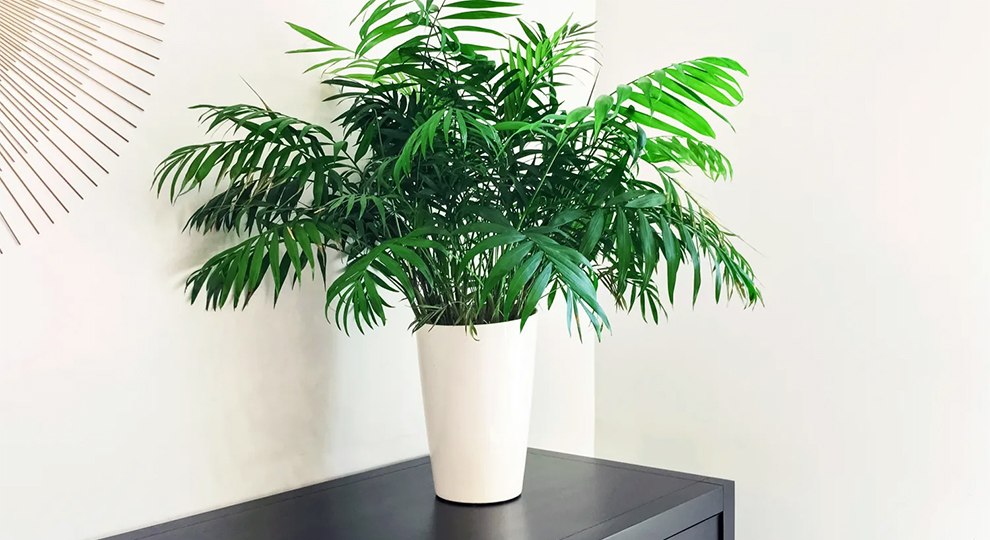
Areca palm and Parlor palm are both popular indoor palm plants that have different uses.
Areca palm is commonly used as a decorative plant in homes and offices due to its attractive foliage and ability to purify the air. It is also used in landscaping and as a source of betel nuts in some cultures. They are also used for weaving and handicraft products.
Parlor palm is also used as a decorative indoor plant but is often used in a different way than the Areca palm. Due to its smaller size, it is often used to fill in small spaces or as a tabletop plant.
It is also used as an accent plant in larger arrangements or as a background plant in terrariums.
Overall, both palms have aesthetic and air-purifying benefits and can be used to enhance the beauty of indoor spaces in different ways.
Related: How to care for indoor palms?
Summing Up: How To Identify An Areca Palm From A Parlor Palm?
To sum up, the physical appearance of both Parlor and areca palm makes them easily identifiable. Parlor palm plants are smaller in size as compared to Areca palm. Areca palms are taller than Parlor palms with slender stems and long leaves.
